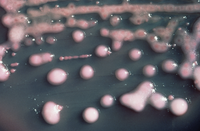
Photo from wikipedia
Asymptomatic laboratory workers who tested positive for SARS-CoV-2 for days to months were found to harbor a laboratory plasmid vector containing SARS-CoV-2 DNA, which they had worked with in the… Click to show full abstract
Asymptomatic laboratory workers who tested positive for SARS-CoV-2 for days to months were found to harbor a laboratory plasmid vector containing SARS-CoV-2 DNA, which they had worked with in the past, in their nasal secretions. While prior studies have documented contamination of research personnel with PCR amplicons, our observation is novel, as these individuals shed the laboratory plasmid over days to months, including during isolation in their homes. ABSTRACT Biomedical personnel can become contaminated with nonhazardous reagents used in the laboratory. We describe molecular studies performed on nasal secretions collected longitudinally from asymptomatic laboratory coworkers to determine if they were infected with severe acute respiratory syndrome coronavirus 2 (SARS-CoV-2) circulating in the community or with SARS-CoV-2 DNA from a plasmid vector. Participants enrolled in a prospective study of incident SARS-CoV-2 infection had nasal swabs collected aseptically by study staff at enrollment, followed by weekly self-collection of anterior nasal swabs. SARS-CoV-2 diagnosis was performed by a real-time PCR test targeting the nucleocapsid gene. PCR tests targeting SARS-CoV-2 nonstructural protein 10 (nsp10), nsp14, and envelope and three regions of the plasmid vector were performed to differentiate amplification of SARS-CoV-2 RNA from the plasmid vector’s DNA. Nasal swabs from four asymptomatic coworkers with positive real-time PCR results for the SARS-CoV-2 nucleocapsid targets were negative when tested for SARS-CoV-2 nsp10, nsp14, and envelope protein. However, nucleic acids extracted from these nasal swabs amplified DNA regions of the plasmid vector used by the coworkers, including the ampicillin and neomycin/kanamycin resistance genes, the promoter-nucleocapsid junction, and unique codon-optimized regions. Nasal swabs from these individuals tested positive repeatedly, including during isolation. Longitudinal detection of plasmid DNA with SARS-CoV-2 nucleocapsid in nasal swabs suggests persistence in nasal tissues or colonizing bacteria. Nonviral plasmid vectors, while regarded as safe laboratory reagents, can interfere with molecular diagnostic tests. These reagents should be handled using proper personal protective equipment to prevent contamination of samples or laboratory personnel. IMPORTANCE Asymptomatic laboratory workers who tested positive for SARS-CoV-2 for days to months were found to harbor a laboratory plasmid vector containing SARS-CoV-2 DNA, which they had worked with in the past, in their nasal secretions. While prior studies have documented contamination of research personnel with PCR amplicons, our observation is novel, as these individuals shed the laboratory plasmid over days to months, including during isolation in their homes. This suggests that the plasmid was in their nasal tissues or that bacteria containing the plasmid had colonized their noses. While plasmids are generally safe, our detection of plasmid DNA in the nasal secretions of laboratory workers for weeks after they had stopped working with the plasmid shows the potential for these reagents to interfere with clinical tests and emphasizes that occupational exposures in the preceding months should be considered when interpreting diagnostic clinical tests.
Journal Title: Microbiology Spectrum
Year Published: 2022
Link to full text (if available)
Share on Social Media: Sign Up to like & get
recommendations!